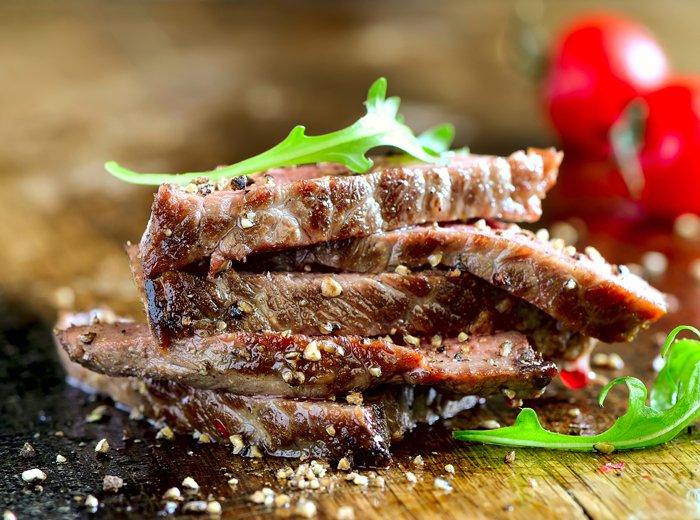Next Item of No Kill, Lag-Growth Filet Mignon Menu from Laboratory to your Dish
1501 Views |

เทคโนโลยีสเต็มเซลล์
การผลิตเนื้อสัตว์ในห้องแล็บ นักวิทยาศาสตร์จะแยกสกัดสเต็มเซลล์หรือเซลล์ต้นกำเนิดของสัตว์ออกมา โดยเลือกใช้เซลล์ต้นกำเนิดที่มีคุณสมบัติในการแบ่งตัว และเปลี่ยนไปเป็นเซลล์ที่ทำหน้าที่เฉพาะเจาะจงได้ จากนั้นจึงนำเซลล์ไปแช่ในของเหลวที่มีสารอาหาร และนำไปใส่ถังหมัก (Bioreactor) ซึ่งเป็นอุปกรณ์สำหรับเลี้ยงจุลินทรีย์ในห้องปฏิบัติการโดยเฉพาะ ปัจจุบันมีการนำเซลล์หลายประเภทมาเพาะเลี้ยง และสามารถสกัดเซลล์จากสัตว์ได้หลากหลายวิธีเช่นกัน โดย Good Food Institute เปิดเผยว่า การเก็บรวบรวมตัวอย่างเซลล์จากสัตว์ที่ยังมีชีวิตเป็นวิธีที่ได้รับความนิยมมากที่สุด และมีผลกระทบต่อสัตว์น้อยที่สุด วิธีนี้ใช้กับสเต็มเซลล์ได้หลายแบบ ซึ่งรวมถึงเซลล์ต้นกำเนิดกล้ามเนื้อยึดกระดูก (Skeletal muscle stem cells) ที่อยู่ในเนื้อเยื่อกล้ามเนื้อ และมีส่วนช่วยในการแบ่งตัวใหม่ของเซลล์เนื้อเยื่อ นักวิจัยยังสามารถแยกเซลล์ต้นกำเนิดออกจากอวัยวะต่างๆ เพื่อนำเซลล์เหล่านั้นมาเพาะเป็นผลิตภัณฑ์ที่แตกต่างจากเดิมได้อีกด้วย เช่น นำเซลล์จากต่อมน้ำนมมาผลิตน้ำนม และนำเซลล์จากไข่เป็ดมาเพาะเป็นฟัวกราส์ที่ผลิตอย่างมีจริยธรรม นอกจากนี้ เทคโนโลยีที่มีอยู่ยังทำให้นักวิจัยสามารถแยกเนื้อเยื่อที่มีชีวิตออกมาจากสัตว์ที่เพิ่งถูกฆ่าใหม่ๆ ได้ และวิธีนี้อาจจะมีบทบาทต่อการกำหนดสถานะของเนื้อสัตว์ที่เพาะเลี้ยงจากเซลล์ในกลุ่มผู้ที่บริโภคอาหารฮาลาลและโคเชอร์ ส่วนการแยกเซลล์ต้นกำเนิดออกจากตัวอ่อนในระยะเริ่มแรก (Pluripotent stem cells) ด้วยการเก็บตัวอย่างจากกระพุ้งแก้มและการเจาะเลือด ก็มีให้เห็นในวงการเพาะเลี้ยงเนื้อสัตว์เช่นเดียวกัน แต่ไม่ว่าจะใช้วิธีไหนนักวิจัยยังคงต้องเลือกเก็บเซลล์จากสัตว์ที่มีสุขภาพแข็งแรงเท่านั้น และจำเป็นต้องมีหลักฐานพิสูจน์ถึงที่มาอย่างถูกต้อง
Stem Cell Technology
Scientists extract stem cells, also known as building block cells, that can self-renew and differentiate from animals to create lab-grown meat. They soak the cells in a nutrient-rich liquid before placing them in a bioreactor. A laboratory device used to grow organisms. So far, we know that meat can be grown using a variety of cell types, and animal cells can be obtained in a variety of ways. According to Good Food Institute, collecting a cell sample from a live animal is the most common method and is accomplished with minimally invasive techniques. It can be used to obtain a variety of stem cells, including skeletal muscle stem cells (satellite cells), which reside in muscle tissue and contribute to muscle tissue renewal. Stem cells can also be obtained by removing cells from specific organs and repurposing them to create new products. Cells from mammary glands, for example, could be used to make milk and duck eggs to make ethical foie gras. Furthermore, viable tissue can sometimes be obtained from a recently slaughtered animal, which could aid in determining the halal or kosher status of any cellular agriculture-derived product. Another approach is to extract pluripotent stem cells (source cells) from an embryo at an early stage through procedures such as a cheek swab or blood draw. Regardless of the method, all cells obtained must be taken from healthy animals, and extensive documentation is required to monitor their validity.
ปัจจุบันมีบริษัทประมาณ 99 แห่งทั่วโลก ที่กำลังพัฒนาเนื้อสัตว์ในห้องทดลอง จากเดิมที่มีเพียงแค่ 4 แห่งในปี 2559 โดยบริษัทสตาร์ทอัพแห่งหนึ่งเลือกใช้กลยุทธ์ที่แปลกใหม่ เน้นมอบประสบการณ์การกินเนื้อสัตว์ที่ แหวกแนวไปจากเดิม และประชาสัมพันธ์ว่าจะเริ่มจำหน่ายสเต็กเสือและเนื้อม้าลายที่เพาะเลี้ยงในห้องแล็บ ให้กับร้านอาหารในสหราชอาณาจักรในอีกไม่นานเกินรอ ในขณะเดียวกันสตาร์ทอัพชั้นนำอื่นๆ ก็ไม่น้อยหน้า ประกาศว่าจะมีผลิตภัณฑ์ออกจำหน่ายในอนาคตอันใกล้เช่นเดียวกัน โดยมีทั้งเนื้อปลาทูน่าและแซลมอนที่เพาะเลี้ยงในห้องแล็บ มีทบอลที่เพาะขึ้นจากเซลล์กล้ามเนื้อและไขมัน และน้ำนมที่ผลิตจากการเพาะเลี้ยงเซลล์ ซึ่งสอดคล้องกับที่มีการคาดการณ์ว่าภายในปี 2573 จะพบเห็นเนื้อสัตว์จากการเพาะเลี้ยงเซลล์วางจำหน่ายทั่วไปในท้องตลาด แม้ว่าจะยังคงมีราคาสูงอยู่มากเมื่อเทียบกับเนื้อสัตว์แบบดั้งเดิม และภายในปี 2583 คาดว่าเนื้อสัตว์ในซุปเปอร์มาร์เก็ตและร้านอาหารทั่วโลกประมาณ ร้อยละ 60 จะเป็นเนื้อที่ผลิตจากกรรมวิธีเพาะเลี้ยงเซลล์
There are currently about 99 companies developing cultured meat around the world, a significant increase from only four in 2016. However, one cellular agriculture start-up is following a different strategy by developing lab-grown exotic meats that, according to the company, can provide novel food experiences. It is about to start selling lab-grown tiger steaks and zebra meat to restaurants in the United Kingdom. At the same time, other leading start-ups claim that their products, such as cell-based foie gras, cell-based tuna and salmon fillets, meatballs made from muscle and fat cells, and cell-based breast milk, will also be available shortly. This corresponds to the prediction that by 2030, cell-based meats will have reached a commercial scale but will remain prohibitively expensive in comparison to traditional meats. By 2040, a projected 60% of the meat will be made from cells grown in bioreactors and sold in grocery stores and restaurants around the world.



